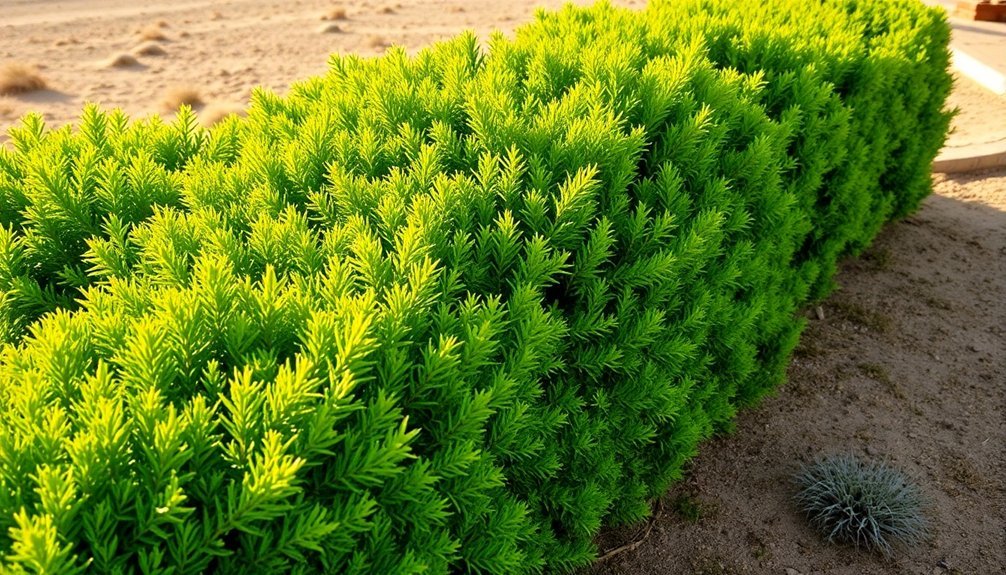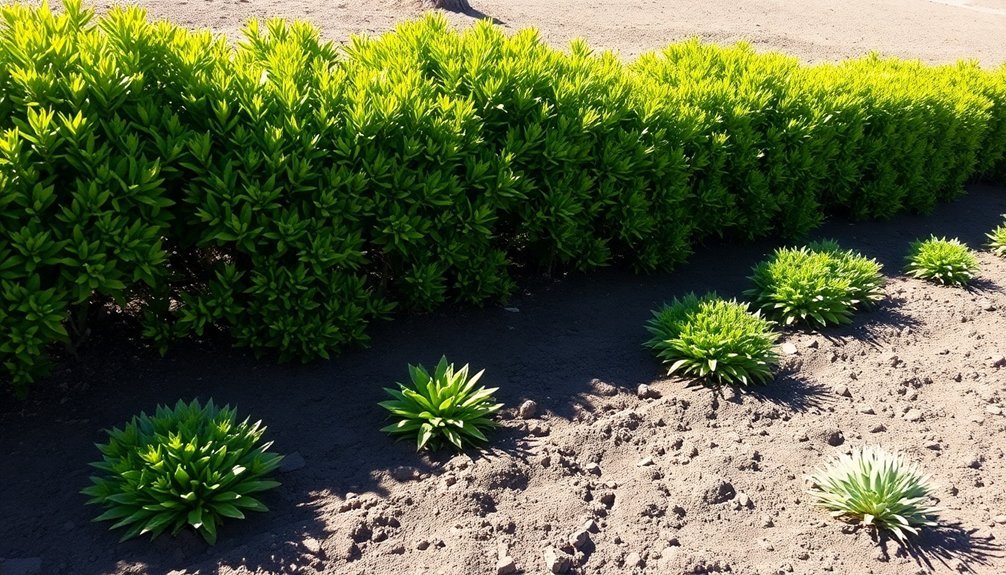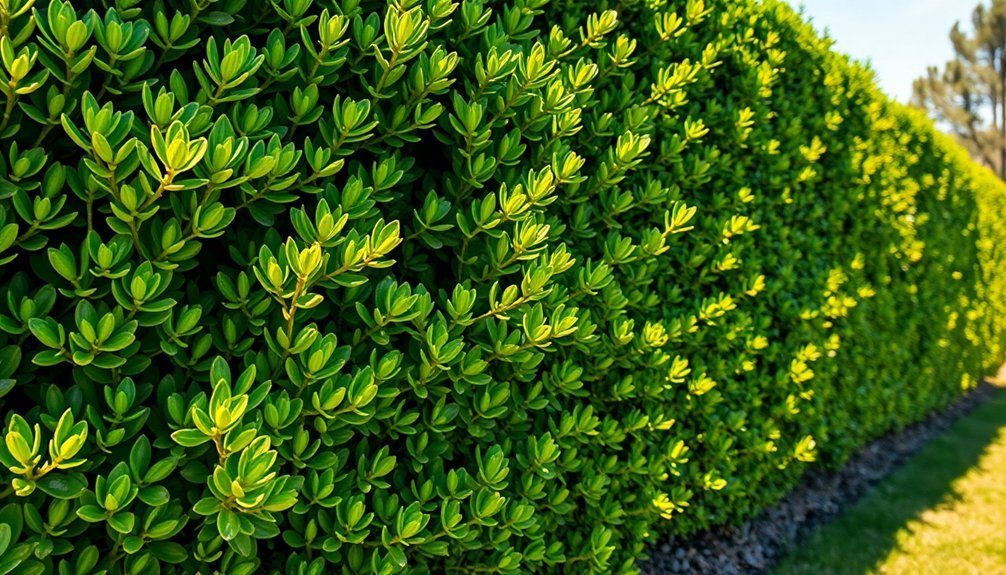For natural drought-tolerant fences, consider boxwood, viburnums, holly varieties, and elaeagnus—all providing dense privacy with minimal water once established. Fast-growing options include English Laurel and Green Giant Arborvitae, adding up to 3 feet annually. Native choices like Ceanothus, Lemonade Berry, and Texas Sage offer region-specific benefits while supporting local wildlife. You'll find the perfect balance of function and sustainability as you explore these water-wise boundary solutions.
Defining Natural Fence Criteria for Drought-Prone Areas

When selecting natural fences for drought-prone areas, you'll need to evaluate several critical factors that determine long-term success.
Success in drought-prone landscapes hinges on selecting fence plants that can withstand moisture scarcity while maintaining their protective function.
Look for plants with small or narrow leaves, which naturally reduce water loss through evapotranspiration—a key trait in species like Coreopsis.
Choose plants with deep root systems that can access underground water sources when surface moisture is scarce. Plants with thick cuticles or waxy leaf coatings will further conserve water in harsh conditions.
Don't overlook adaptability to your specific soil type, especially if it has poor water retention. Native species often perform best as they've already adapted to local climate patterns.
For ideal results, group plants with similar water needs together, and consider adding mulch or gravel to minimize evaporation from surrounding soil. These natural boundaries not only conserve water but also support local ecosystems by providing habitat for beneficial wildlife and enhancing biodiversity.
Top Evergreen Hedges for Year-Round Privacy Barriers
Your search for year-round privacy solutions can end with three outstanding evergreen options.
Boxwood creates dense, elegant screens that maintain their structure in drought conditions without excessive watering.
Viburnums offer lush, versatile barriers with varied leaf textures, while holly varieties provide not only effective privacy shields but also valuable habitat and food sources for local wildlife. For an attractive and drought-resistant natural fence, consider Elaeagnus varieties that create effective privacy and windbreaks with their fragrant blooms and appealing foliage.
Boxwood's Dense Privacy Screens
Numerous homeowners choose boxwood hedges for privacy screens due to their exceptional density and year-round foliage. These versatile plants thrive in USDA zones 4-9 and can be maintained at various heights to suit your privacy needs.
Once established, boxwoods require minimal maintenance while providing maximum benefits. You'll appreciate their drought tolerance and ability to block unwanted views with their tight growth pattern. Their deer resistant qualities make them particularly valuable in rural or suburban settings where wildlife pressure is high.
| Boxwood Benefits | Growing Conditions | Maintenance Tips |
|---|---|---|
| Evergreen privacy | Partial to full sun | Prune regularly |
| Drought resistant | Well-draining soil | Water weekly when dry |
| Noise reduction | Zones 4-9 | Mulch to retain moisture |
| Dense foliage | Tolerates heat | Fertilize spring/fall |
| Versatile heights | Minimal watering | Monitor for fungal issues |
For ideal privacy screening, plant boxwoods 12-18 inches apart to create an impenetrable living fence.
Viburnums For Lush Barriers
Viburnums stand as exceptional alternatives to boxwoods when seeking lush, year-round privacy barriers with drought-resistant qualities.
These versatile shrubs offer impressive adaptability to various soil types and growing conditions, thriving in both full sun and partial shade.
Once established, viburnums require minimal watering, making them perfect for water-conscious landscapes.
Species like Henry's Viburnum attract pollinators, while Leatherleaf Viburnum provides attractive foliage year-round.
For wildlife enthusiasts, Arrowwood Viburnum produces berries that birds love.
Plant them approximately one meter apart for an effective screen.
Their diverse growth patterns—from upright and slender to round and bushy—let you choose the perfect viburnum for your space.
With regular pruning, they'll maintain their shape while creating dense barriers that offer both privacy and ecological benefits.
The Thin Fence™ variety grows in a fastigiate habit, developing more height than width for spaces where narrow screening is essential.
Holly's Wildlife-Friendly Shields
Holly varieties stand as nature's perfect shields, offering drought-tolerant privacy while nurturing local wildlife. These versatile evergreens require minimal pruning while providing year-round seclusion for your garden.
Their spiny foliage creates natural barriers against intruders while simultaneously protecting birds from predators.
You'll appreciate holly's ecological benefits beyond security. The berries serve as essential winter food sources for birds and small mammals when other nourishment is scarce.
Position these hedges near bird feeders to create protected feeding zones that cats and larger predators can't easily access.
For maximum biodiversity, consider combining holly with other drought-resistant options like berberis or pyracantha. Unlike typical American yards that favor openness, these dense hedges offer the privacy and exclusion often sought by those wanting a more secluded garden space.
With proper mulching, your holly hedge will thrive in various soil conditions while supporting local wildlife and maintaining its dense, protective structure with minimal water requirements.
Fast-Growing Options for Quick Natural Boundaries
When establishing a natural boundary quickly, homeowners can turn to several fast-growing hedges that won't wilt at the first sign of drought.
English Laurel and Green Giant Arborvitae lead the pack, each growing up to 3 feet annually, with some Arborvitae reaching an impressive 5 feet per year.
For low-maintenance options, consider Schip Laurel, which requires just one pruning session annually to maintain its tall, narrow profile. Proper spring pruning stimulates vigorous new growth and helps maintain dense, attractive hedges.
Portuguese Laurel thrives in poor soils and warm climates, making it ideal for challenging landscapes.
Texas Privet offers fire resistance along with drought tolerance, needing extra water only during extreme heat waves.
Texas Privet stands as a fire-resistant barrier against drought, requiring minimal extra attention even during scorching summer conditions.
All these varieties adapt to various soil conditions, though Green Giant Arborvitae prefers well-draining soil.
Once established, you'll enjoy privacy with minimal watering requirements.
Native Species That Thrive in Low-Water Conditions

Native drought-tolerant shrubs like Ceanothus and Arrowwood offer you region-specific options that'll thrive while conserving water in your landscape.
You'll find California natives such as Lemonade Berry create substantial barriers, while Eastern species like Shadbush provide seasonal interest with flowers and berries.
These indigenous plants maintain effective boundaries year-round while supporting local wildlife and requiring minimal irrigation once established. For gardeners with sandy soils seeking drought-resistant options, consider planting bayberry or wild rose to create beautiful living fences that thrive in challenging conditions.
Region-Specific Native Options
Selecting the right native plants for your particular region guarantees a thriving, drought-resistant hedge with minimal maintenance requirements.
On the East Coast, Eastern Red Cedar and American Holly make excellent natural fences, offering year-round foliage and habitat benefits.
If you're in Southern California, consider drought-adapted options like California Wax Myrtle along coastal areas or Texas Sage for inland locations.
Western gardeners will find Manzanita particularly resilient during dry periods, with its distinctive red bark and ability to thrive in challenging conditions.
These region-specific natives have developed deep root systems and water-storing adaptations that minimize irrigation needs.
They'll also attract local wildlife and pollinators while requiring fewer pesticides than non-native alternatives.
Visit local native plant nurseries to find specimens already acclimated to your specific microclimate.
Red Chokeberry serves as an excellent addition to East Coast hedgerows with its vibrant red berries and spectacular fall color displays.
Year-Round Barrier Benefits
Beyond regional considerations, drought-tolerant hedges offer remarkable year-round advantages even in the harshest conditions. These living fences create protective microclimates that shield other plants while their deep root systems conserve soil moisture and prevent erosion.
You'll benefit from reduced maintenance as these hedges require less frequent pruning than traditional options. They're also powerful ecological allies, sequestering carbon and supporting essential wildlife. Drought-tolerant species like jujube thrive in poor soils and provide multifunctional benefits throughout their lifespan.
| Benefit Type | Warm Season | Cold Season |
|---|---|---|
| Protection | Wind buffer for crops | Snow barrier, wildlife shelter |
| Ecological | Pollinator habitat, shade | Food source when other plants dormant |
| Economic | Reduced water bills | Lower maintenance costs, potential fodder |
These sustainable barriers work tirelessly year-round, creating resilient landscapes that serve both you and the local ecosystem.
Height and Density Considerations for Effective Screening
When planning a privacy hedge for your drought-prone landscape, the height and density of your chosen plants will determine how effectively they screen unwanted views.
Tall options like Leyland Cypress reach 10-15 feet, creating substantial barriers, while medium-height Manhattan Euonymus (4-6 feet) works well in partially shaded areas.
For density, look for plants with naturally thick growth habits:
- Boxwood and American Holly provide dense, evergreen coverage that maintains privacy year-round.
- Fast-growing options like English Laurel can add up to 3 feet per year, quickly establishing your living fence.
- Schip Laurel offers excellent screening in shaded areas, with minimal maintenance requirements.
Remember that faster-growing hedges typically require more frequent pruning to maintain their shape, while slower-growing native options may take longer to establish but offer greater long-term sustainability. Grouping hedge plants according to their water requirements ensures efficient irrigation and healthier growth throughout your natural fence.
Soil Preparation Techniques for Drought-Tolerant Hedge Success

Proper soil preparation forms the foundation of any successful drought-tolerant hedge installation. Begin by evaluating your soil's quality, drainage capability, and pH levels. For heavy clay soils, incorporate sand or perlite to improve aeration, while organic matter like compost enhances water retention in sandy soils.
| Soil Type | Recommended Amendment | Benefits |
|---|---|---|
| Clay | Sand or perlite | Improves drainage and prevents root rot |
| Sandy | Compost or aged manure | Increases water retention and nutrients |
| Acidic | Lime | Raises pH for alkaline-loving plants |
| Alkaline | Sulfur | Lowers pH for acid-loving plants |
| Compacted | Sharp gravel | Creates drainage pathways for roots |
Apply a 2-3 inch layer of organic mulch around your plants, keeping it away from stems to prevent rot. Ensure you maintain at least a 2 inch depth of mulch throughout the growing season for maximum moisture retention benefits. Combine this with efficient irrigation like drip systems to maximize water conservation.
Watering and Establishment Strategies for the First Year
The first year represents the most critical period for establishing drought-tolerant hedges. Focus on developing deep root systems through strategic watering.
Plant in fall to minimize initial water needs, then provide deep, infrequent irrigation that gradually decreases as plants establish themselves. Consider adding hedges with waxy leaves that naturally retain moisture and reduce water loss through transpiration.
- Apply 3-4 inches of mulch immediately after planting to retain soil moisture, regulate temperature, and suppress competing weeds.
- Use drip irrigation or soaker hoses to deliver water directly to roots, reducing waste and encouraging deeper growth.
- Monitor soil moisture regularly with a moisture meter, watching for signs of drought stress like wilting or leaf curl.
Minimize fertilization during this period, as it increases water demand.
Create windbreaks if necessary to protect young plants from drying winds.
Pruning Methods to Maintain Dense Natural Fences

Strategic pruning transforms scattered shrubs into cohesive, drought-resistant living barriers. For drought-tolerant species like Toyon and Natal Plum, timing and technique are essential to maintaining density without excessive water demands.
| Hedge Type | Pruning Timing | Technique |
|---|---|---|
| Formal | Early summer (evergreens) Late winter (deciduous) |
Shearing with upside-down V shape |
| Informal | After flowering | Selective thinning, less frequent |
| Overgrown | Staged over 3 years | Renewal pruning, removing 1/3 annually |
You'll achieve denser growth by maintaining a wider base than top, allowing sunlight to reach all parts of the hedge. For Australian Rosemary and Grevillea, use hand pruners for detailed work rather than shears. Regular removal of dead branches encourages new growth from the base, creating natural drought-resistant fences that don't sacrifice density for water efficiency. Always wear appropriate safety equipment when pruning to protect yourself from sharp branches and debris.
Wildlife-Friendly Hedge Choices That Conserve Water
Beyond maintaining your hedge's shape and density, selecting the right species can create a water-efficient sanctuary for local wildlife.
Drought-tolerant hedges like Berberis provide shelter with their spiny foliage while producing berries that attract birds. Hawthorn offers similar benefits with minimal water requirements, creating essential habitat in dry landscapes. However, artificial hedge alternatives provide eco-friendly benefits while eliminating the need for water resources entirely.
- Holly combines drought tolerance with winter berries that feed birds while its dense growth provides protection from predators.
- Lavender requires little water while supporting pollinators, particularly bees seeking nectar during dry periods.
- Hazelnut (Corylus avellana) provides nuts for wildlife and early-season pollen while adapting well to drought conditions once established.
These choices deliver dual benefits—conserving precious water resources while supporting biodiversity in your garden ecosystem.
Frequently Asked Questions
How Do Drought-Tolerant Hedges Affect Property Values?
Drought-tolerant hedges can increase your property value by 5-17% while lowering your maintenance costs. You'll save on water bills and attract eco-conscious buyers who appreciate the sustainable, visually appealing landscape you've created.
Can These Hedges Withstand Extreme Temperature Fluctuations?
Yes, many drought-tolerant hedges can withstand temperature extremes. You'll find Green Beauty Boxwood, Italian Cypress, and Euonymus particularly resilient. They've adapted to survive both heat waves and cold snaps with minimal stress.
Are There Thorny Drought-Resistant Options for Security Purposes?
Yes, you'll find several thorny, drought-resistant options for security. Consider Pyracantha, Hawthorn, or Berberis for attractive barriers. Prickly Pear Cactus and Acacia varieties also provide formidable protection while thriving in dry conditions.
How Do Artificial and Natural Drought-Tolerant Hedges Compare Financially?
While you'll pay more upfront for artificial hedges, they'll save you money long-term on water, pruning, and maintenance costs. Natural hedges cost less initially but require ongoing expenses for their care.
What Are Typical Lifespan Expectations for Drought-Tolerant Hedge Varieties?
You'll find drought-tolerant hedge lifespans vary considerably. Boxwood can thrive for decades, while dwarf varieties like Abelia and Pittosporum typically last under 10 years. Holm Oak can survive for centuries with proper care.
In Summary
You'll find success with drought-tolerant natural fences by matching the right plant to your specific conditions. Whether you've chosen boxwood, juniper, or native alternatives, remember that proper establishment in year one determines long-term health. With minimal water needs and strategic pruning, your living fence won't just survive drought conditions—it'll thrive while providing privacy, wildlife habitat, and lasting beauty in your landscape.





Leave a Reply